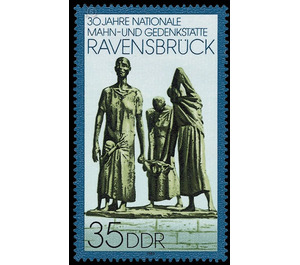Commemorative stamp series - Germany / German Democratic Republic 1989 - 35 Pfennig
Theme: Architecture
| Country | Germany / German Democratic Republic |
| Issue Date | 1989 |
| Face Value | 35.00 |
| Color | blue |
| Perforation | K 14 |
| Printing Type | Rotogravure 2 |
| Stamp Type | Postage stamp |
| Item Type | Stamp |
| Chronological Issue Number | 3016 |
| Chronological Chapter | GER-DDR |
| Michel ID | DDR 3274 |
| SID | 926446 |
| In 9 Wishlists | |
30th Anniversary of Ravensbrück National Remembrance and Memorial On the occasion of the 30th anniversary of the Ravensbrück National Remembrance and Memorial Center, the Ministry of Posts and Telecommunications of the German Democratic Republic has issued a multicolored postage stamp. Special cancellations from September 5 to November 4, 1989 In 1955, when the 10th anniversary of the liberation of the German people from fascism took place, a board of trustees under the chairmanship of the then Prime Minister Otto Grotewohl addressed a call to the citizens of the GDR for the design of national institutions Memorials in the territories of the former fascist concentration camps Buchenwald, Sachsenhausen and Ravensbrück. Preserving the memory of the victims of the peoples brought against fascism was regarded as the national duty of honor of all German patriots. The call received a wide response - donations and voluntary work hours in the "National Building Project" were provided to a considerable extent, indicating that the anti-fascist resistance struggle had already found its way into the tradition of the citizens.Three years of construction took place on the eastern shore of the Schwedtsee The architectural design of the architectural collective L. Deiters, H. Grotewohl, H. Kutzat and K. Tausendschön, the "Frauengruppe" and the memorial with the "Tragenden" of the sculptor Professor Will Lammert (1892-1957) With great sympathy of former prisoners from numerous countries and over 30,000 citizens from all districts of the Republic, Rosa Thälmann, a former prisoner of the camp, consecrated this memorial on September 12, 1959. In the 30 years of existence The memorial has about 4.3 million visitors to the women of Paid tribute to Ravensbrück, informed themselves about the victim-rich anti-fascist resistance struggle and international solidarity in the concentration camp. Every fourth visitor came from abroad, and 75 countries around the world are now on the guest list. In Ravensbrück existed from May 1939 to April 1945, a large women's concentration camp. The SS deported an estimated 132,000 people - women, children and men - to these concentration camps in those years. Here and from 1943 onwards, in more than 70 satellite camps, they were driven to work for the SS and the armaments industry. Among them women from all European countries: fascist resistance fighters and partisans, persecuted for racial and religious reasons, arrested as "potential adversaries" and outcasts as "criminals" or "asocials" of civil society. Tens of thousands were killed due to heavy work, hunger and epidemics, were killed in other places and from January 1945 in Ravensbrück with gas. Mostly on the death march to the west, the survivors were released in early May by units of the 2nd Belorussian Front of the Red Army. The special postage stamp shows the bronze "mother group", which was set up in 1965 at the beginning of the camp territory. Professor Fritz Cremer (born 1906) formed three women who carry a sick child on a stretcher in a different mental state, while another looks for protection in the mother's robe. In the concentration camp there were temporarily about 400 children, over 500 were born here from summer 1944 to spring 1945. In the - usually futile - struggle for the lives of children, women saw their primary task, as the life of a child is the epitome of all hopes for the future.
| Condition | Name | In Stock | Price | Price + Shipping | Store | |
|---|---|---|---|---|---|---|
 | Unmounted Mint ** | Commemorative stamp series - Germany / German Democratic Republic 1989 - 35 Pfennig | 10 | US $0.323 | US $3.54 |  FILATELIELOKET (0) FILATELIELOKET (0)Shipping US $3.22 Minimum Order US $2.69 |


